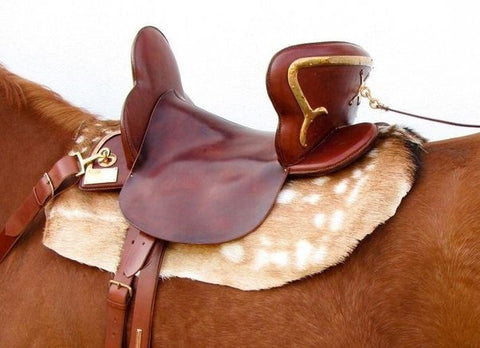A Brief Saddle History
Posted by John Brand on
Evidence exists that the predecessor to the modern saddle was in use by the Assyrians in 700-800 BCE. It consisted of a simple cloth fastened onto the horse with a surcingle. These early saddles had neither a solid tree nor stirrups. By 300 BC, the Samaritans added a breastplate and girth to keep the saddle on.
 The development of the solid saddle tree was significant; it raised the rider above the horse's back, and distributed the rider's weight on the animal's spine. This change greatly increased the comfort of the horse and prolonged its useful life. The invention of the solid saddle tree also allowed development of the stirrup. Without a solid tree, the rider's weight in the stirrups creates abnormal pressure points and makes the horse's back sore.
The development of the solid saddle tree was significant; it raised the rider above the horse's back, and distributed the rider's weight on the animal's spine. This change greatly increased the comfort of the horse and prolonged its useful life. The invention of the solid saddle tree also allowed development of the stirrup. Without a solid tree, the rider's weight in the stirrups creates abnormal pressure points and makes the horse's back sore.
The first stirrup like object was invented in India, and consisted of a simple leather strap in which the rider's toe was placed. It offered very little support. The nomadic tribes in northern China are thought to have been the inventors of the modern stirrup. The stirrup appeared to be in widespread use across China by 477 AD. The stirrup and its use then spread to Europe.


During the Middle Ages, the nights needed a saddle that could help hold them in place and support the weight of heavy armor and weapons. This resulted in a saddle that was built on a wooden tree with both a higher pommel and cantle, making it much harder to knock a rider off during battle. This saddle was padded with wool or horsehair and covered in leather or fabric.
The American stock saddle evolved from the early Spanish Conquistador’s war saddle. The Mexican Vaqueros adapted the saddle, which had a heavy, rigid tree, high fork, high cantle, deep-dished seat, leather skirt and short stirrups. In the late 1700's, the Mexican "California" saddle came about. It had a fixed, round skirt, along with a more substantial rigging. The rigging, which consisted of a cinch ring that hung down in line with the front fork and a horizontal strap that ran from the cinch to the back of the tree, secured the saddle. The strong high-peaked pommels of this saddle were ideal for taking a turn around a rope for holding an animal. The Texans then altered the design even more. They kept the wooden tree, horn, cantle and stamped leather but they modified the wooden horn so it was short, thick and covered in leather. The skirt was changed to a plain square skirt and the stirrups were made out of wide, bent pieces of wood which were much stronger than the ones previously used. A second cinch was also added to firmly anchor the saddle. In the 1870's they changed the horn again to a short metal one, as the wooden ones often broke when dealing with a wild cow.
During this time saddle makers were spread throughout the west and were quite busy making and repairing saddles. Many new designs and innovations came about with the input that they received from ranchers, cowboys and the influx from the East. There were many different styles of saddles seen, the "Plantation-style," "Morgan," "Hope" and "Cheyenne" were just a few.
Today, there is no end to the saddles that are designed for a wide variety of uses and riders, from close contact English saddles, endurance saddles, and all types of saddles for Western disciplines.
Buckaroo Leather offers three styles of saddles for you to chose from that best fit your needs. Head over to www.buckarooleather.com and order yours today!


